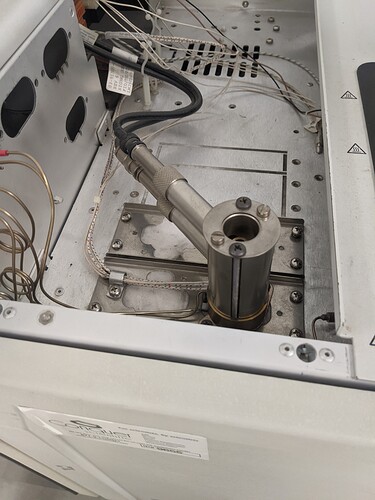At my old university we had an electron microscope that only worked with Windows NT. Getting that fixed when the computer died was a pain!
Hopefully it won’t be a problem but I always like to have a B plan.
You really need to get it to work because the library feature is the most useful part of the whole thing.
Oh absolutely going to, but I’ve done this before with older CNC equipment and am fully prepared for a hunt for the correct 16 bit system with the correct original com ports drivers and it can take a month or two
For old computers we use hp 4200s. They communicate with windows 95 to modern computers and are absolute workhorses of printers. Mine had just under a half million pages through it.
Great to know, I’ll keep it in mind if I go to buy a printer for the machine
You may also be able to use virtualbox or similar to do it.
Good first step!
virtualization is your friend!!
So doing some digging around and it looks like I got a GCMS AND FID! Yay free detectors (someone tell me if I’m misidentifying this thing lol)
Looks like an FID to me!
SCORE!!!
The tag even says fid
Lol this is the same level of investigation that I performed.
Now if I’m too stupid to make the MS numbers mean anything I might have a snowballs chance in hell of getting a result
FOR sure, i know 0 about MS but i know FID pretty well and i know you are a wise guy. you should have it dialed in no time!
When configured for gcms, am I correct in thinking that its simply an oven/column that feeds the saturn 2000 ms unit? I ask because I’ve always wondering how difficult it would be to mate a saturn to a non agilent gc.
Yes, it seems to be exactly that. There’s literally just a hole punched in the side of the GC oven that the MS body sticks into and has a nut to thread the column to. I see no reason you couldn’t add one to another unit. Only thing I can think of is synchronizing the method start time.
The GC itself seems super modular. There’s spots for multiple detectors, looks like all you’d need to do to run tandem FID is buy another detector, bolt it on, and plug it in. Same deal with the injection, there’s clearly spots for 3.
If there’s a difficulty , it would only be on the software end.
Does the saturn have its own connection to the pc? Or does it have its data cable connected to the cp-3800, which would then link to the pc? Completely agree with @MagisterChemist in the software difficulty and value. I was thinking, if the saturn feeds data directly to the pc (maybe via that gpib port ive seen in pictures), then theres maybe hope to getting it running on another gc while still being able to utilize the library. Thanks for this info @SidViscous; excited to see the progress!
I believe it has its own connection, let me take a look in the AM. I also have every manual ever written for both pieces of equipment as well as the software so I’ll throw those up here soon. @Cassin is super knowledgeable about these systems so definitely hit her up with specific questions. I’m pretty sure the response from the MS is nearly straight analog signal
Edit: included in my data drop is a copy of MS Workstation V7 which supposedly supports the Saturn 2000
I agree software could be an issue - but if you are doing things by hand anyway… you could just dump the data to a database side-by-side and write up the integration parameters. There are some open source applications that do similar things, and you can get “most” of the data out of it in csv.
I think you should also consider alignment issues. I’m sure you could use shims or something to make sure everything comes out at the right angles. -shrug- In my experience, getting things to hook up seamlessly while also not interfering with flow rates has always been an issue. Even with instruments intended to work together which have been hobbled in some way (like…you don’t have a table that is the right height… or you have one table that leans a little, etc.)

